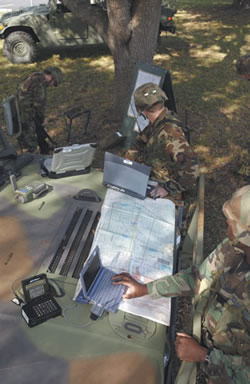Specific computerized equipment is designed to support infantry operations. While the BMS may be similar, the smaller displays, limited communications capabilities, requirements for visual and audible stealth, and portable electrical power limitations dictate special adaptations to be made in these C2 applications. A typical element used for dismounted operations, including patrols, and support for team leaders, is the rugged Tablet Computer or Rugged Personal Digital Assistant (RPDA). Team leaders, platoon and company commanders may also use special observation devices, integrated with digital displays, compass and laser rangefinders, maintaining efficient situational awareness, command and control under covert conditions on ambushes, special operations etc.
 Infantry warriors will soon use digital 3D audio, enhanced weapons sights, embedded with digital displays, or monocular eyepieces to display C2 information, maps and situational pictures right before their eyes. Introduction of wearable computers will add more powerful features for such applications, including 3D situational displays and of immersive (virtual reality) visualization augmenting current electro-optical viewing capabilities with real-time presentation of blue forces positions and threats, automatic target recognition, as well as support for operational planning and training. Such features are currently available only in large simulators.
Infantry warriors will soon use digital 3D audio, enhanced weapons sights, embedded with digital displays, or monocular eyepieces to display C2 information, maps and situational pictures right before their eyes. Introduction of wearable computers will add more powerful features for such applications, including 3D situational displays and of immersive (virtual reality) visualization augmenting current electro-optical viewing capabilities with real-time presentation of blue forces positions and threats, automatic target recognition, as well as support for operational planning and training. Such features are currently available only in large simulators.
This feature continues to cover the following topics:
- Tactical C4 Networking Challenges
- Building Blocks of C4 Systems
- Vehicular C4 Applications
- C4 for the Battalion Level
- Situation Assessment Tools For Dismounted Leaders
- Brigade’s Tactical Operations Center
- Common Operation Picture (COP)
- The Modern Command post
- C4 Networking Architecture
- Mission planning Tools



















